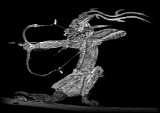
Asian Traditional Archery Research Network (ATARN)
Text and
photographs © Stephen Selby, Sally Selby, 2001 - 2002.
A1, Cloudridge,
30, Plunkett’s Road,
The Peak, Hong Kong.
Fax: (852) 2808-2887
email: srselby@atarn.org
June 2002
Dear All,
ATARN has just completed a mission to Qinghai and Xinjiang in the People's Republic of China. Led by the Vice-President of the Chinese Archery Association, Mr. Xu Kaicai, the mission was strongly supported by local governments and sports bodies, who made elaborate arrangements for our transport and accommodation.
Our 'team' in Qinghai, led by Mr Xu, consisted of myself, my wife, Anne, my sister, Sally, Trinidad Campbell (ATARN Member from Argentina who lives in Los Angeles), Qinghai senior provincial archery coach, Qi Guihua and a television camera crew from Radio Television Hong Kong.
During the trip, we were able to investigate traditional archery among the Tibetan and Hui Muslim people, traditional bow-making at the local level, historic bows and arrows excavated among the mummies of the Taklamakan Desert and the surviving archery tradition of the Xibe people - descendants of the Xianbi of Manchuria - who still speak and read the Manchu language.
ATARN owes a debt of gratitude to the local governments, sporting bodies, cultural and archaeological authorities of Qinghai Province and the Xinjiang Uighur Atonomous Region of the People's Republic of China, as well as to our warm and hospitable hosts among the Tibetan, Han, Uighur and Xibe people.
The fruits of this mission are too many to describe in one letter. This month I am starting off with a description of Tibetan traditional archery in Qinghai and local bow-making. Future news letters will report further on this trip.
Qinghai is a province of China that used to be known as the Amdo region of North Tibet. The population consists mainly of Han Chinese, Tibetans Mongols and Hui Muslims.
As among other cultural groups in China, archery was supressed in the 1960s as part of the Cultural Revolution 'Smash to Four Olds' campaign. Luckily, however, not all the old bows were destroyed. I saw ten traditional horn bows in use, some of which, with repairs and some re-cylcling, had been in existence for three hundred years. Bows are passed from generation to generation: only a 'good' son can inherit his father's bow.
In Qinghai, traditional archery has been revived on the imitative of a group of retired Communist Party cadres - indeed possibly some of those at whose behest it must have been suppressed in the Cultural Revolution! Associations of people are still closely supervised in China, and it took the dedication of these retired cadres with their high-level Party links to be able to set up the traditional archery association, known as the 'Qinghai Province Retired Cadres' Sports and Recreation Association.'
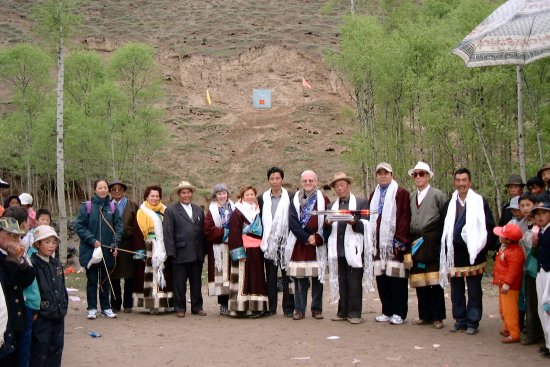
Reviving traditional archery in Northern Tibet is not easy. There are not enough traditional bows to go around. Those who want to shoot often buy locally-made fiberglass western bows that cost around 600 Yuan (US$77) each. Many of the local villagers only earn around US$200 a year. People with an annual income of over 5,000 Yuan pay 500 yuan to join the Association, otherwise the joining fee is $50 Yuan. Anyone (not just retired cadres) is welcome to join.
The association aims to organize five to ten competitions a year. Each competition is a two-day event, with the first day held at the 'home' team's village and the second at the 'away' team. Transport over great distances and prodigious entertainment with lavish eating and drinking make these events expensive to mount, at a cost of about 5,000 Yuan (US$640) each time.
High in the hills of Ledu County (Tibetan Drotsang county, birthplace of the Dalai Lama,) we drove up the muddy road to Xinya ─ the village of the 'away' team. The 'home' team following in a bus behind us. At the border of the village, a reception committee met us with ceremonial 'hadag' white silk scarves, barley cakes and small cups of distilled barley spirit. Already the amplified singing of Tibetan folk music was audible in the distance.
The competition
There are just two teams in a competition, with up to fifty archers in each. Only men take part: Tibetan women are strictly debarred from touching bows. In their traditional belief, doing so means that they must refrain from sex for a period of time after the 'infraction'.
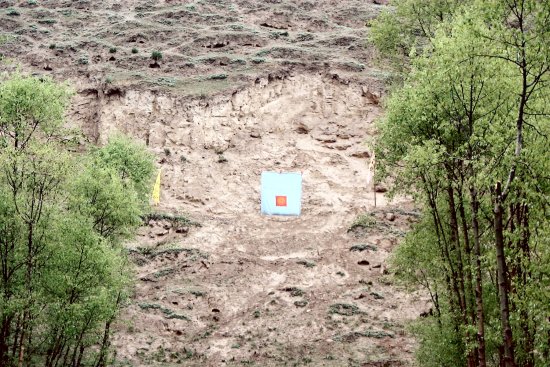
The target is placed at 100 paces (in fact, 94 metres) from the shooting line. At the home match, the target was at ground level but in Xinya village, it was placed up a cliff at about 16 metres above the shooting line. The target face was a 3 x 3 metre cloth stretched over a wooden frame with a red spot in the centre. In earlier times, the target was made of willow twigs bound together to make a target face. A hit anywhere on the target cloth or on the wooden frame scores a point. All the archers in both teams take turns to shoot three rounds with one arrow in each round, and the score is tallied up with score cards.
Judges (one from each team) stand at the firing line and next to the target with a flag to indicate a hit or miss.
bow.jpg)
Our first stop was at the village Gonpa (shrine) where a monk took offerings of money, the prayer wheel was turned, and all the visiting team's bows were taken three times round a fire burning outside the gates of the shrine.
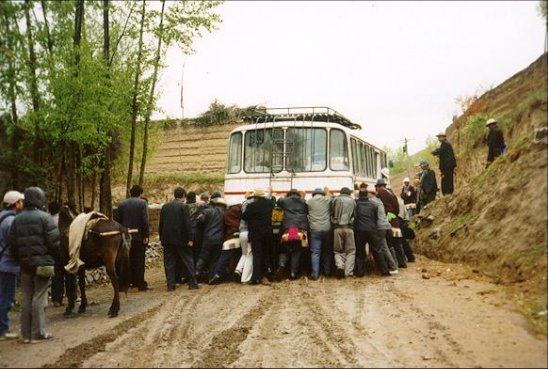
The home team, together with an enthusiastic crowd of women and children awaited us at the shooting ground: a fallow field bounded on each side by a stand of birch and willow trees, with a clear view ahead to the target face up on the hillside.
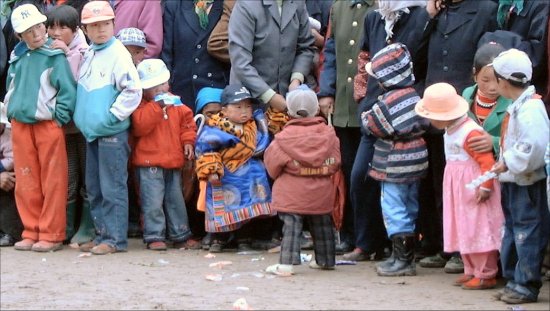
Nothing starts until a large quantity of strong alcohol has been taken by both sides. Carrying trays of home-distilled barley wine, both men and women accost their guests singing in Tibetan "You are honoured guests from far away; we welcome you with fine wine." No-one may refuse a sip from each of the three glasses!
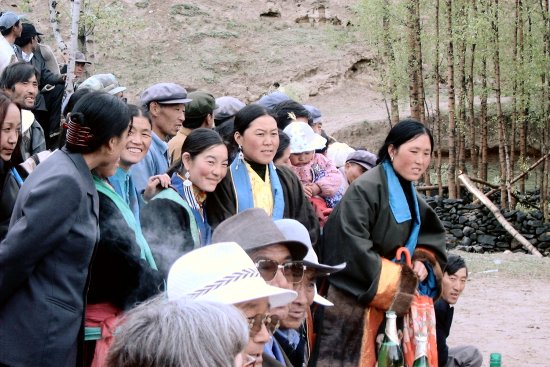
Most of the archers and the on-lookers of both sexes are dressed in colourful Tibetan coats with white felt hats. The men's coats have long, hanging sleeves, and the archer's left arm is left out of his sleeve. His hat - which looks like a cowboy hat from a Western movie, has a popper which allows the rim to be clipped up on the right side out of the way of the bowstring.
As each archer comes to the shooting line, his team supports him with whistles and a short, yelping call that ends in a low hum like the chant of monks at prayer. The archer sets up his stance (sometimes with some advice from the team judge), aims and shoots.
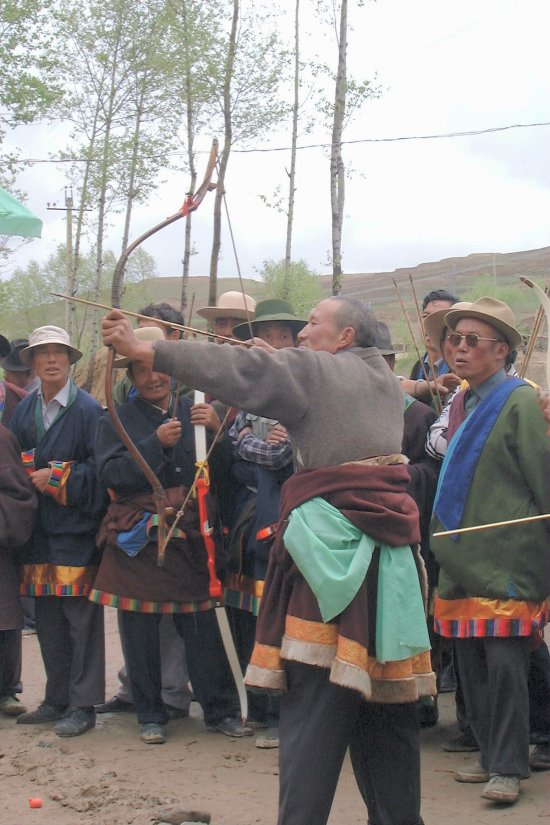
Immediately, he jumps forward from the firing line in a show of bravado, anticipating his hit. If he hits, he leads his team in a dance up the archery range (oblivious to any shooting by the other team.)
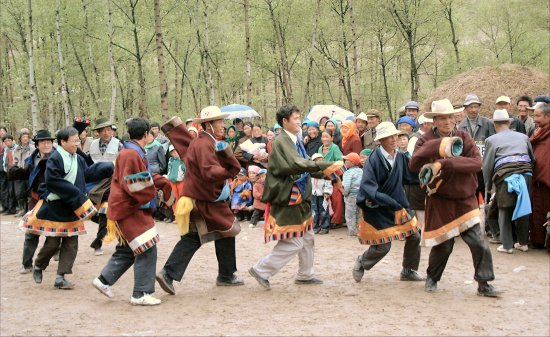
The dance is full of gusto: three or four steps with the long sleeves of the Tibetan coat twirled above the head, followed by stamping the feet on the ground with the sleeves twirled low. None of the set-piece Chinese adaptations of Tibetan folk-dance here! It is a war dance with accompaniment of a chant without words in rhythm with the stamping of the archers' feet.
The archer who scored has rushed forward with his bow, but a team-mate soon takes the bow from him while another leads the group of dancers. A third team-member waits at the shooting line to greet the dancers back to the line. Double whistles greet the archer who manages to score two shots in succession.
Remembering descriptions the Bhutanese archery competitions, I asked if there was any tradition of cursing the opposing team. Our hosts admitted that in some parts of Tibet, there were still such traditions, but they were frowned upon. Nowadays, archers are supposed to encourage each-other - not curse.
No attempt has been made to standardize shooting technique. The greatest variation is in the release. All the archers of both teams shot over the knuckle, but I saw two-finger draws, Mediterranean draws, pinch draws and two varieties of thumbring draw - both the Manchu and the Mongolian draw. Those who used thumbrings all had simple, cylindrical bone, copper or jade rings lined with soft leather or toilet paper, some with a red ribbon tied around for luck.
|
|
|
|
On the shooting line
Tibetan archers like to place their feet nearly at right-angles and lean into the bow at the draw, bringing the nock to the corner of the mouth. To cover the distance of over 90 metres, bows have to have a draw weight of at least 45 pounds. (I shot with a little 48-pound Korean FRP bow from Tom Duvernay that was greatly admired.)

The fertility symbolism of archery among the Tibetans of Amdo is clear. Archery regularly takes place either at the Chinese Yuan Xiao festival (15th day of the first lunar month) or the Tibetan planting festival (25th day of the second lunar month.) The finely-dressed young men in the teams of archers, and the young women on-lookers in their Tibetan finery and jewels are a clear-give away. According to tradition, in the evening following the end of an archery competition, the shooting ground becomes the trysting place for the young men and women of the village.
VIDEO CLIPS
| 1 | 2 | 3 | 4 | 5 | 6 |
Bows
The Tibetan legend has it that horn bows first came to Tibet from China in the Tang Dynasty as part of the dowry of Princess Wen Cheng (d. 680) who was given in marriage to the King of Tibet, Songzan Ganbu in 642, bearing a dowry including Chinese technological secrets of agriculture, sericulture, building and paper-making.
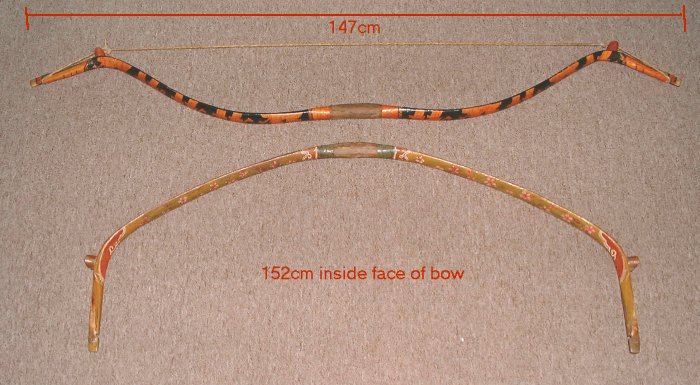
Most of the horn bows I saw were identical to ones I had previously bought from the Qinghai area. Many were probably not made in the area, but imported from adjacent provinces. Depending on the profile of the splice between the limb and the siyah, one can detect bows originating both in Peking and in Xian over the past two centuries.
All the Tibetan horn bows have had their siyahs cut back from their Manchu-style originals. The Tibetans say that the long siyahs favoured by the Manchus slow the bow down too much. (This is undoubtedly true for Tibetan archery, with relatively light bows and light, wooden arrows.) Only rawhide was used to make the bowstrings.

The arrows are finely-made barrelled poplar arrows with self-nocks, 78cm long with a 2cm iron tip. The maximum thickness is 1cm. The triple-fletching is 23cm in length with a maximum depth of 7mm. They are extremely expensive to buy at 100 Yuan each. Most archers therefore make their own or use commercially-available aluminum arrows.
I went to visit a local bowyer in Minhe County (Tib. Drotsang county.) Mr Ma is a Hui Muslim who used to be a fine archer in his youth. He could place three arrows in succession into a target at 100 paces. Now 65 years old, he repairs and occasionally makes bows together with his third son.
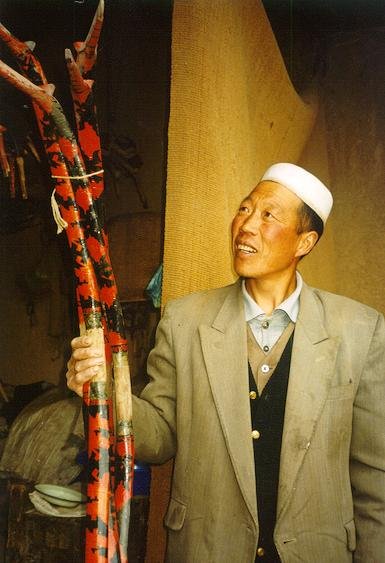
There are just three local craftsmen who can repair horn bows. Due to a lack of raw materials, few bows are currently being made from scratch; but craftsmen will make up a new bow if they can find materials to re-cycle.
Ma charges 150 Yuan to mend a damaged horn bow. The most common fault is detachment of the sinew from the limb, for which the whole limb has to be re-built. If a new bow is made, the Ma charges around 350 Yuan for it. Due to maintenance problems, many Tibetans have bought a poor-quality, Chinese-made 'Zhonghua' brand fiberglass recurves (a design based on a basic Samick) at a cost of about 500-600 Yuan new.
Ma learned bow-making from another bowyer who lived far away in the mountains of an adjacent county. He uses a wood he called 'black ci' (black date. Also known by a local name, 'sha ji mu'. ) for the core and mulberry for the siyahs. If he can't re-cycle water buffalo horn from an old bow, he uses yak horn that he bends into shape after heating it in water. Usually, yak horn is not long enough and he has to use more than one piece. In that case, at least 2/3 of the centre part of the belly must be covered with a single piece of horn. Smaller pieces can be cut to make up the length at the grip and the siyah splice.
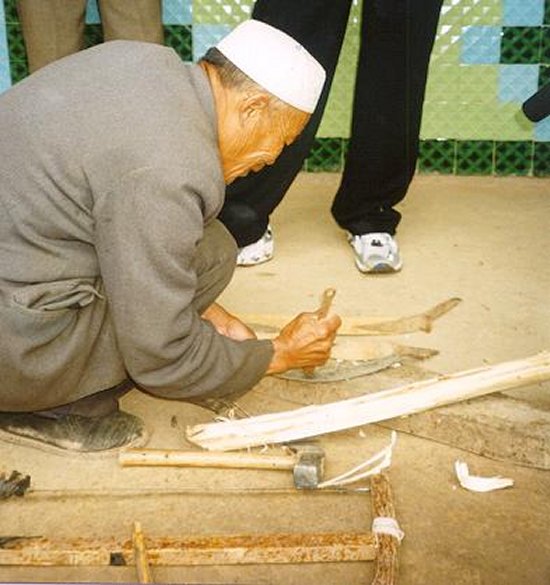
His only tools are an axe, a saw, a file and a knife. He uses a commercially-available fish glue which comes in small granules, and heats it in water on a charcoal stove. Sinew is applied in seven successive layers with a minimum drying time of two weeks per layer. Before a new layer of sinew is added, the top of the previous layer is dampened with water and scraped with the oblique blade of the knife. (The resulting bows were around 70 pounds to draw when new; but settled back to 50 pounds over a period of time.) The grip is bound with a cork-like bark from the 'yellow ci' tree.
When the sinewing is finished, he tillers the bow by feel, bending the limb around his legs. He adds additional sinew to the weaker limb. (Limbs can only be tillered up - not down.) The string is then put on and if the two limbs bend unevenly, the more rounded of the limbs is bound to the string with a bow-bag so as to apply pressure to it and bring the bow back into shape.
Ma revealed that the Muslim Hui minority also organize traditional archery competitions at which Tibetans and Han Chinese join in. There are 15-20 archers in each team. Hui Muslims are not drinkers, so they make up for drinking by having elaborate picnics. Like the Tibetan archers, teams call out when the target is hit; but there is no singing or dancing. Muslims say that a woman must not touch a bow, otherwise the bow will never shoot straight again.
As with the Tibetans, young Hui men and women make dates to meet at the archery ground after the competitions.
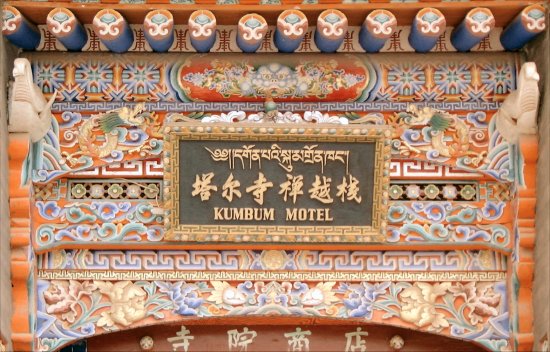
What is it about building projects? Why can't they be nice and simple like shooting arrows?
The Hong Kong museum archery collection's building programme has been put back until about February 2003. That means that both the museum opening and the mini-conference have to be delayed until then. I will try to set a firm date as soon as I can and let everyone know.
Watch this space.
|
|
(Signed) (Stephen Selby) |